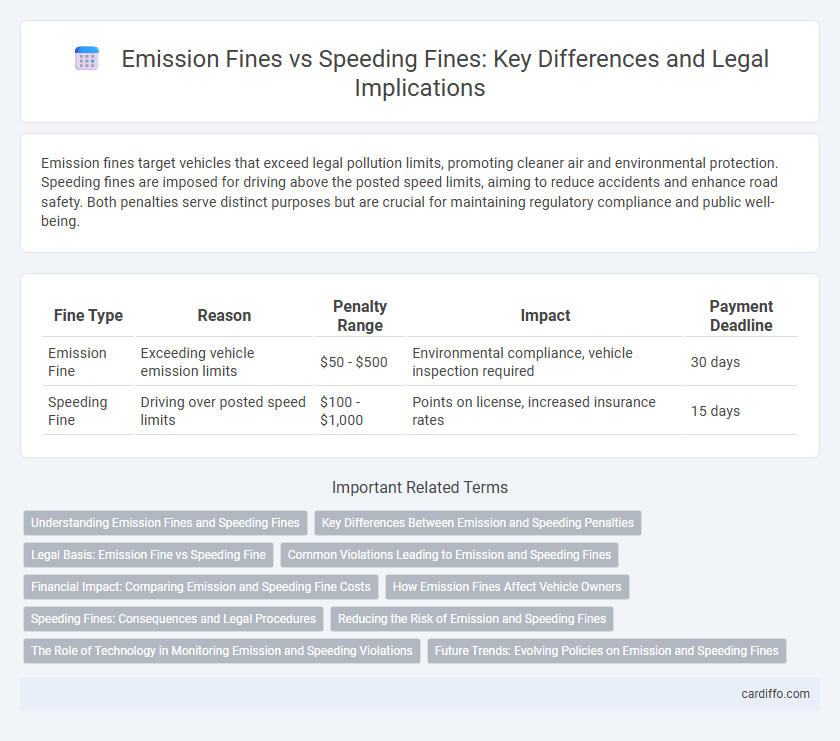Emission fines target vehicles that exceed legal pollution limits, promoting cleaner air and environmental protection. Speeding fines are imposed for driving above the posted speed limits, aiming to reduce accidents and enhance road safety. Both penalties serve distinct purposes but are crucial for maintaining regulatory compliance and public well-being.
Table of Comparison
| Fine Type | Reason | Penalty Range | Impact | Payment Deadline |
|---|---|---|---|---|
| Emission Fine | Exceeding vehicle emission limits | $50 - $500 | Environmental compliance, vehicle inspection required | 30 days |
| Speeding Fine | Driving over posted speed limits | $100 - $1,000 | Points on license, increased insurance rates | 15 days |
Understanding Emission Fines and Speeding Fines
Emission fines are penalties imposed for exceeding legal limits on vehicle pollutants, aimed at reducing air pollution and protecting environmental health. Speeding fines result from surpassing posted speed limits, designed to enhance road safety and prevent accidents. Both fines serve regulatory roles but target different aspects of driving compliance: environmental standards and traffic laws respectively.
Key Differences Between Emission and Speeding Penalties
Emission fines target vehicles that fail to meet established environmental standards, aiming to reduce harmful pollutants and improve air quality. Speeding fines are imposed for exceeding posted speed limits, prioritizing road safety and traffic regulation enforcement. Both penalties serve different regulatory objectives, with emission fines focusing on environmental protection and speeding fines emphasizing accident prevention.
Legal Basis: Emission Fine vs Speeding Fine
The legal basis for emission fines is established under environmental protection laws targeting pollutants and vehicle emissions standards, such as the Clean Air Act in the United States or the European Union's Euro emission standards. Speeding fines derive from traffic laws and regulations, typically governed by national or state vehicle codes, aiming to ensure road safety and reduce accident risks. Both fines serve distinct regulatory purposes, with emission fines enforcing air quality compliance and speeding fines promoting adherence to speed limits.
Common Violations Leading to Emission and Speeding Fines
Common violations leading to emission fines include failing vehicle inspections, tampering with emission control devices, and exceeding allowable pollution limits. Speeding fines often result from exceeding posted speed limits, reckless driving in school zones, and speeding in construction areas. Both types of fines aim to ensure road safety and reduce environmental impact by enforcing compliance with traffic and environmental regulations.
Financial Impact: Comparing Emission and Speeding Fine Costs
Emission fines typically impose higher financial penalties due to their association with environmental regulations and mandatory repair costs, often ranging from $100 to over $1,000 depending on the severity of the violation. Speeding fines generally vary between $50 to $500, influenced by the speed exceedance and jurisdiction, but may incur additional costs such as increased insurance premiums. The long-term financial impact of emission fines often surpasses speeding fines because of required vehicle repairs and potential compliance mitigation expenses.
How Emission Fines Affect Vehicle Owners
Emission fines directly impact vehicle owners by imposing financial penalties for exceeding regulated pollution limits, encouraging the maintenance of cleaner engines and timely emission tests. These fines incentivize upgrades to exhaust systems or shifts to low-emission vehicles, reducing environmental harm and promoting air quality. Non-compliance can lead to costly repairs, increased operational expenses, and potential restrictions on vehicle registration or use.
Speeding Fines: Consequences and Legal Procedures
Speeding fines carry significant legal consequences, including points on the driver's license, increased insurance premiums, and potential court appearances depending on the severity of the offense. In many jurisdictions, exceeding speed limits by substantial margins can lead to license suspension or revocation, mandatory traffic school, and even criminal charges in cases of reckless driving. Legal procedures for speeding fines often involve receiving a citation, the option to contest the ticket in traffic court, and adhering to deadlines for payment or appeal to avoid further penalties.
Reducing the Risk of Emission and Speeding Fines
Reducing the risk of emission and speeding fines requires regular vehicle maintenance and adherence to speed limits, supported by monitoring tools like emission testing and speed cameras. Using eco-friendly driving habits such as smooth acceleration and deceleration helps minimize emissions while maintaining legal speeds prevents costly penalties. Investing in real-time GPS tracking systems can provide alerts to avoid both emission violations and speeding tickets effectively.
The Role of Technology in Monitoring Emission and Speeding Violations
Advanced technology such as automated number plate recognition (ANPR) and optical sensors play a crucial role in monitoring both emission and speeding violations by providing real-time data and accurate detection. Emission control devices like remote sensing equipment assess vehicle pollutants on the road, enabling authorities to issue emission fines promptly. Speed cameras use radar and lidar systems to measure vehicle speed precisely, ensuring effective enforcement of speeding fines and enhancing road safety.
Future Trends: Evolving Policies on Emission and Speeding Fines
Emerging regulations are increasingly integrating real-time data analytics and AI to dynamically adjust emission fines based on pollution levels and traffic conditions, enhancing environmental accountability. Speeding fines are expected to incorporate biometric and telematics technology, allowing personalized penalties that reflect driving behavior patterns rather than fixed amounts. Governments are prioritizing these adaptive policies to synergize road safety improvements with climate change mitigation goals, promoting sustainable transportation frameworks.
Emission Fine vs Speeding Fine Infographic

 cardiffo.com
cardiffo.com